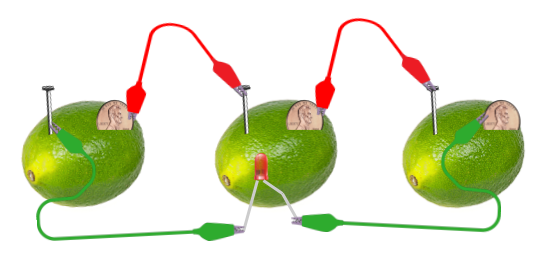How many limes does it take to light up a LED?
Build a lime battery. Connect multiple batteries until the LED lights up.


The battery was invented in 1799 when Alessandro Volta soaked copper and zinc probes into saltwater brine. If he connected enough of the probes, he could feel electricity. We can replicate this experiment using limes, pennies, and zinc nails.


- Insert nail and penny into lime. (You may need to cut a slit for the penny.)
- Touch the long pin (+) of the LED to the nail, and the short pin (-) to the penny.
One lime is not enough to light up a LED.
Optional Voltage Test: Use a multimeter to test the voltage of a lime. How many volts does a lime produce?


3. Just like the ends of a battery, connect positive to negative. In this case, clip the gator wires from nail to penny, nail to penny.
4. Add the LED to see if it lights up.

Experiment Questions:
- About how much voltage does a lime produce?
- About how many limes does it take to light up a LED?
- About how much voltage is needed to light up a red LED?
- How many limes would it take to blow up a red LED?
- Besides limes, what other fruits, vegetables, or substances could we test? Try potatoes, tomatoes, pineapple, or cheese. How do you think they would compare to limes?
Content connection: chemistry, molecular physics, circuits, electricity, voltage, polarity